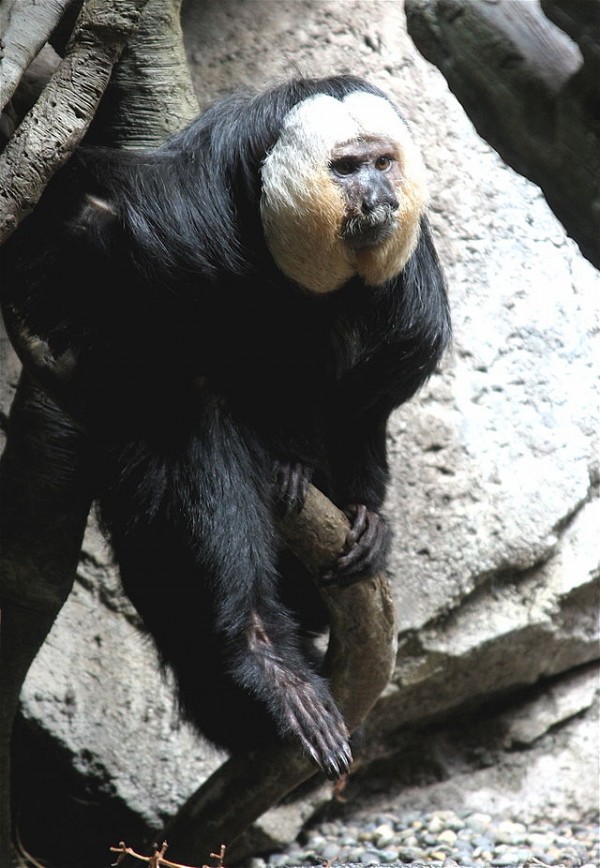Five New Acrobatic Monkey Species Confirmed In Amazon
| Des Cambaliza | | Aug 31, 2014 11:06 AM EDT |
(Photo : Photo from http://en.wikipedia.org) A flying or acrobatic monkey known as "saki" belongs to the Pithecia genus. Five new species were confirmed in the Amazon recently.
Five new species of flying or acrobatic monkeys in the Amazon were recently confirmed by scientists, according to a study. The newbie "saki" monkeys had been previously identified, but were too elusive for scientific research.
According to the International Union for Conservation of Nature (IUCN) and Conservation International, the sakis were named as Cazuza's saki, Isabel's saki, Mittermeier's Tapajós saki, Pissinatti's bald-faced saki and Rylands' bald-faced saki.
Like Us on Facebook
Sakis are primates that weigh about eight pounds (four kilograms) and are distinguishable by their colorful facial hair and bushy coats.
They are extremely shy and quick to jump from treetop to treetop when disturbed.
Ten years ago, director and cofounder of the Global Conservation Institute, Laura Marsh, became interested in sakis in Ecuador.
She initially described them as "fluffy, kinda uglyish cats that run on the tops of trees."
She also noted that some of her sightings were not in her field guide. This prompted her to research more about the sakis and create its family tree.
For almost 10 years, she studied 800 skins, 690 skulls, and hundreds of photographs in natural museums of 17 countries.
Marsh and her team found out that they belong to the Pithecia genus, which now has 16 species.
They also make the following sounds: "grunts, chirps, whistles, and low calls." But they can be awfully quiet when hiding from perceived threats, according to Marsh's study.
A single species has notable differences in terms of color, sizes, and other distinguishing factors.
For example, some female saki specimens have protruding clitorises, which the scientists misidentified as penises. Also, juvenile sakis have similar colors as the adult females.
Although Marsh's study was deemed comprehensive, more research is needed. They have yet to analyze genetics and distribution.
Marsh said the next step includes investigation of the five species' population and vulnerability in its ecosystem.
While previous studies indicate the sakis' adaption in human-affected environment, a deeper research would reveal their status in the wild.
TagsAmazon, flying monkey, saki, Global Conservation Institute, Laura Marsh, IUCN, Conservation International, International Union for Conservation of Nature
©2015 Chinatopix All rights reserved. Do not reproduce without permission
EDITOR'S PICKS
-

Did the Trump administration just announce plans for a trade war with ‘hostile’ China and Russia?
-

US Senate passes Taiwan travel bill slammed by China
-

As Yan Sihong’s family grieves, here are other Chinese students who went missing abroad. Some have never been found
-

Beijing blasts Western critics who ‘smear China’ with the term sharp power
-

China Envoy Seeks to Defuse Tensions With U.S. as a Trade War Brews
-

Singapore's Deputy PM Provides Bitcoin Vote of Confidence Amid China's Blanket Bans
-

China warns investors over risks in overseas virtual currency trading
-

Chinese government most trustworthy: survey
-

Kashima Antlers On Course For Back-To-Back Titles
MOST POPULAR
LATEST NEWS
Zhou Yongkang: China's Former Security Chief Sentenced to Life in Prison

China's former Chief of the Ministry of Public Security, Zhou Yongkang, has been given a life sentence after he was found guilty of abusing his office, bribery and deliberately ... Full Article
TRENDING STORY

China Pork Prices Expected to Stabilize As The Supplies Recover

Elephone P9000 Smartphone is now on Sale on Amazon India

There's a Big Chance Cliffhangers Won't Still Be Resolved When Grey's Anatomy Season 13 Returns

Supreme Court Ruled on Samsung vs Apple Dispute for Patent Infringement

Microsoft Surface Pro 5 Rumors and Release Date: What is the Latest?










